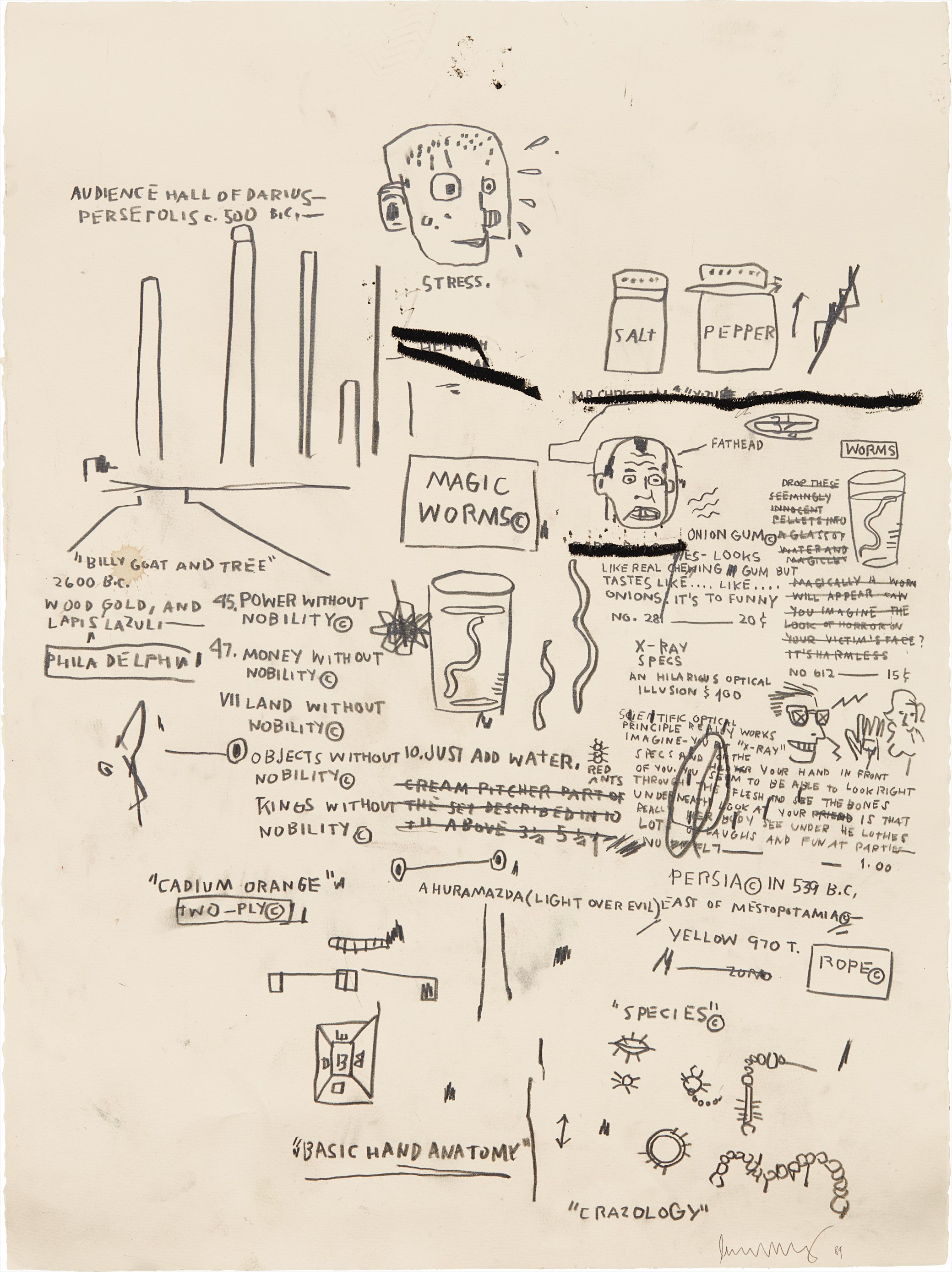

16Ο◆
Jean-Michel Basquiat
Untitled (Magic Worms)
Full-Cataloguing
Brimming with line drawings, symbols and cryptic poetry, Untitled (Magic Worms), 1984, delivers the full breadth of Jean-Michel Basquiat’s raw and iconoclastic vernacular. Building his composition through a burst of text and signs, Basquiat creates an exceptional drawing that is both personal and encyclopedic – delighting in the depiction of vintage novelty pranks like “magic worms,” “x-ray specs” and “onion gum” advertised in 1960s era comic books, while simultaneously integrating ambivalent references to his own biography, history, jazz and ancient art, including his signature © symbol. Executed in 1984, Untitled (Magic Worms) was created at the height of Basquiat’s notoriously short, but prodigious artistic career that was recently celebrated in the Barbican Art Gallery’s Basquiat: Boom for Real in London. Drawn with confident lines, it speaks to the assured hand of a fully mature artist, who, at the mere age of 23, already had four major solo shows across America, Europe, and Japan under his belt and had become the youngest artist to ever be included in the Whitney Biennial that same year.
An outstanding example of Basquiat’s celebrated draughtsmanship, Untitled (Magic Worms) pulsates with the unbridled immediacy that is unique to the act of drawing. “From a very early age”, Fred Hoffman recalled, “Basquiat discovered that drawing was a process of ‘channeling’ in which he essentially functioned as a medium. In doing so, he also learned about a freedom from editing. That is, as impressions, observations and thoughts passed through him, he recognized that he did not need to prioritize or judge them” (Fred Hoffman, Jean-Michel Basquiat Drawing, exh. cat., Acquavella Galleries, New York, 2014, p. 33). In the process, Basquiat embraced writing and drawing interchangeably without prioritizing either – seamlessly integrating image and text into one pictorial field. In Untitled (Magic Worms), Basquiat has crossed and obscured parts of the text. “I cross out words so you will see them more”, he explained. “The fact that they are obscured makes you want to read them” (Jean-Michel Basquiat, quoted in Dieter Buchhart and Sam Keller, eds., Basquiat, exh. cat., Fondation Beyeler, Basel, 2010, p. XXII).
As the viewer’s attention is drawn to the crossed out words, it becomes clear that Basquiat was here wittily referencing comic books, cartoons and the vernacular of youth popular culture. Basquiat, who as a child had aspired to be a cartoonist, was an avid collector of comic books, newspaper comic strips and regularly worked to the sound of TV cartoons while they played in the background of his studio. The present work references the full-page advertisements Basquiat would have seen on the inside cover of King Features and DC Comics from the late 1960s, including Madrake the Magician, Batman, The Phantom, Jimmy Olsen, and many others. Billed as “A Treasure Chest of Fun”, this advertisement offered a smattering array of cheap mail-order novelty toys, of which Basquiat here selected such items as “x-ray specs”, “magic worms” and “onion gum” – motifs that Basquiat consistently returned to in several works between 1983 and 1987.
Untitled (Magic Worms) is also an intimate ode to Basquiat’s great jazz idol Charlie Parker, one of the most influential improvising soloists in music and a key figure in the development of bebop in the 1940s. In the present drawing, Basquiat alludes to his icon by alluding to Parker’s album “CRAZEOLOGY” at the bottom right, as well as by calling Parker’s nickname of “Bird” to mind way of the inclusion of “worm” in reference, perhaps, to the jazz soloist’s 1949 composition “Bird Gets the Worm”. Basquiat felt a particularly deep affinity for the accomplishments and struggles of Parker, having risen to meteoric fame in a white art world in a manner that seemed to parallel Parker’s own groundbreaking, but also tragic, career.
The all-over composition of Untitled (Magic Worms) reveals the esoteric inner workings of Basquiat’s own encyclopedic mind, where references to comics and jazz mingle alongside a host of symbols, words and ideograms that touch upon such disparate fields as anatomy, poetry, history, the art historical canon, religion, and mythology. Basquiat exploits the creative potential of free association to construct a more ambivalent and loaded image, one that powerfully demonstrates how, as Glenn O’Brien observed “He ate up every image, every word, every bit of data and he processed it all...into a bebop cubist pop art cartoon gospel that synthesized the whole overload we lived under into something that made an astonishing new sense” (Glenn O’Brien, quoted in Dieter Buchhart, ed., Basquiat: Boom for Real, exh. cat., Barbican Art Gallery, London, 2017, p. 189).
Jean-Michel Basquiat
American | B. 1960 D. 1988One of the most famous American artists of all time, Jean-Michel Basquiat first gained notoriety as a subversive graffiti-artist and street poet in the late 1970s. Operating under the pseudonym SAMO, he emblazoned the abandoned walls of the city with his unique blend of enigmatic symbols, icons and aphorisms. A voracious autodidact, by 1980, at 22-years of age, Basquiat began to direct his extraordinary talent towards painting and drawing. His powerful works brilliantly captured the zeitgeist of the 1980s New York underground scene and catapulted Basquiat on a dizzying meteoric ascent to international stardom that would only be put to a halt by his untimely death in 1988.
Basquiat's iconoclastic oeuvre revolves around the human figure. Exploiting the creative potential of free association and past experience, he created deeply personal, often autobiographical, images by drawing liberally from such disparate fields as urban street culture, music, poetry, Christian iconography, African-American and Aztec cultural histories and a broad range of art historical sources.